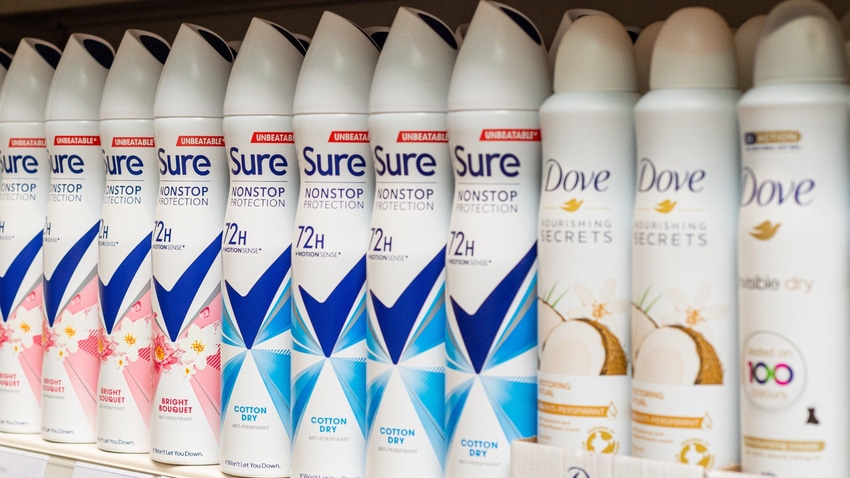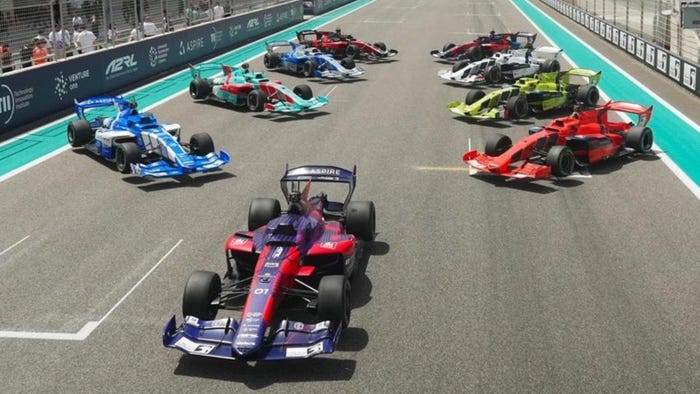Unilever’s Global Science and Tech VP on AI in Personal Care
Unilever's Samantha Tucker-Samaras talks data considerations when testing products for beauty and personal care
June 13, 2023

Samantha Tucker-Samaras, Unilever's global vice president for science and technology, beauty and personal Care R&D talks to AI Business about how one of the world's largest consumer goods companies applies AI across a host of products and research.
Listen to the podcast below or read the edited transcript.
AI Business: Can you tell us a little bit about your background and how you came to your role today
Samantha Tucker-Samaras: I lead science and technology across two of our business groups at Unilever: Beauty and well-being and personal care. Science and technology is a fancy name for upstream innovation. What my team and I do is we work at pulling external waves of science and technology into Unilever and use them to understand different aspects of unmet consumer needs.
Something like dandruff or dry skin, these are unmet consumer needs that people all over the world share. We work on addressing those through science and technology ... and make sure that we're able to address all consumers (whether it's someone) who lives in Shanghai, China, whose hair and skin type are very different than, say, mine, who lives in rural New Jersey outside of Manhattan in the United States. Our climate is different; our genetics are different. Our culture is different - what's the norm for food, what's the norm for sleep, what's the norm for stress are all different. These all contribute to your overall well-being, which is driven a lot by your daily routines and the products and services that you use every day.
AI Business: You bring a deep bench of science to the table. What does your team do? And how do you prioritize focus areas and projects?
Samantha Tucker-Samaras: The way Unilever is set up is in a discover, design and deploy kind of R&D organization and I sit in the discover piece of it in science and technology. Across the world, we have six global labs and about 5,000 R&D experts. But we work with the idea of always putting the consumer at the center of what we're doing. All the cool gadgets and all the cool technology we could invent would not matter if they don't get into a product that a consumer wants to use.
All of our products are products that you have to want to use. And the way we choose what we're going to work on is all centered around bringing differentiated products to our consumers. And there's a ton of science in that. If you think of the science behind the actual unmet need, like dry skin or smelly armpits, everyone wants to look their best. We have many brands around the world. Each of them means something to the consumer. And so the technology and science that we have to develop, it has to be congruent and drive the purpose of that brand as well.
Everything comes from being consumer-centric. And then we back up into scientifically, how do we deliver that benefit? We have people on the team who know more about the sweat gland than anyone else in the world. Not only do we need to make products that work and be able to prove that they work - and talk about how they work in a compelling way - but they also have to stay together, be shelf stable, safe and all those things.
AI Business: Where does Unilever apply artificial intelligence?
Tucker-Samaras: We use AI across the business in many different ways and have been using it for a long time. I think the first random forest model came out in the 1960s, so it's not like this is new. But two things that have changed in my area of research are the compute power and the ability to structure metadata and put it in a place that's rational so you can pull things together in a way that you couldn't 10 years ago.
In the 'old days' of discovery, we would say, 'let's take people who are in the U.S. Some have dandruff and some don't have dandruff. Let's take a sample. Let's look at the top 10 genes that go up and the top 10 genes that go down when comparing these two groups. (Each cell turns on a fraction of its genes at any given point.) And then you go to each gene to see what it does. ... In this huge complex system, there's a tipping point - for example, Gene 375 changes by 0.2%, which then causes a change and causes another change. We never ever, ever, ever could have seen that tipping point by doing the top 10 up and downs.
What AI has really allowed us to do is - combined with this plumbing of being able to access large datasets - we're able to now learn things that we could not learn before. Not only can we do it with one kind of data, we're now at the advent of being able to pull multi-sets of data together, such as your genetic data, your protein data, your inflammation data. And we can start pulling in non-structured data like consumer perception data, survey data or sales data and combine it with more structured data. AI has allowed us to, in non-technical terms, squish that all together and pull insights out and link relationships that the human brain on its own just doesn't have the compute power to do. That's really what's changed in the last five to 10 years.
AI Business: Do you gather all your own data?
Tucker-Samaras: We do and gather quite a lot of data. For example, we have been investing in and working on the microbiome for quite some time. And, within the walls of Unilever, we have three times the data that the Human Microbiome Project itself has. It's a large data repository that we build on every year through clinical studies. We're doing a very large study in North America right now to understand polycultural America. Representation of all skin types, all genetic types in the world is a problem (to be solved). Unilever is a very large company based all over the world. So we serve consumers from everywhere. We do learn from that data.
We’re also using more sophisticated AI models that can move us further into predicting spaces that maybe we don’t have data in. We do that, for example, in the formulation space. So your shampoo that you used in the shower this morning is a colloid made up of 15, 20 different ingredients, all of which have a role in the structure of it, the feel of it, and the performance of it. The science of that formulation space is very specific. You can imagine how many experiments you'd have to do if you wanted to optimize 15 different components.
Stay updated. Subscribe to the AI Business newsletter
What we can do with some of these newer AI models that can predict if we pick the right spaces in that space, it can predict the places that we haven't filled in with experimental data, because it learns from the data that we are generating. And it predicts that. We're doing that in multiple places. I do think there is quite a lot of buzz at the moment in this prediction piece of AI but the prediction is only ever as good as the data that you feed it.
AI Business: Can you talk about how you've grown and managed your data over time to get the right kinds of data?
Tucker-Samaras: It's what I call plumbing. If you don't have the right plumbing and you don’t have the right structure, or even structure around unstructured data, you can't use that data. You have to have the right metadata associated with it, you have to know where it came from. You have to know, for example, did I collect this data on Asian females between the age of 45 and 70 or did I collect this data on millennials in Mexico who are interested in hair straightening? Those are just two consumer groups.
Five years from now, if I don't know which group is which by my metadata, I can't use that data sensibly. I need to know the Genesis from whence it came to be able to make any sort of conclusion.
We've put a lot of effort and a lot of resources over the years into building the right plumbing into secure data lakes, where we keep our data, into partnerships with companies like EBI (European Bioinformatics Institute) in the U.K. where we access data with them. There's internal data and there's external data. Both are valuable and become really valuable when you put them together.
AI Business: What are you seeing in terms of ROI on what you’re doing with AI?
Tucker-Samaras: I can give you a couple of examples if that would be helpful. We have a really great example with a prestige brand we own in North America called Hourglass. Their whole purpose and reason for being is around vegan natural beauty. All of their products are that.
However, red lipstick is probably the cornerstone of a cosmetics brand. The red lipstick comes from something called Red Carmine, which is made from crushed beetles — very hard to be vegan if you're getting a pigment from crushed beetles. There are about 1,000 crushed beetles in a single lipstick. And that red is a very specific color: the depth of it, how it layers on the lips. The lips have a very specific translucency based on the way the epidermis or the skin layers in the lips work.
We used AI to really look across the whole chessboard of pigments. ... We used a huge chessboard AI to come up with a combination of natural vegan pigments that are equally as vibrant as red carmine. And using computational models, we were able to test new combinations of gradients. It would have taken millions of physical experiments to replicate. ... We could have done it without AI, but it would have taken us five years. And with it, it took us 18 months.
AI Business: When did Unilever get started in AI?
Tucker-Samaras: I've been at Unilever for seven years, and they were investing way before I got here. In the area of science and technology, we've been investing in things like microbiome data for about 15 years. And the AI associated with that, we've got great external partners we work with, including a startup called Eagle Genomics. They have helped us build those pipelines so we don't always do it alone. There are some great subject matter experts out there who are building capability in these spaces. We also work with some of the larger guys in the space like Microsoft and IBM.
AI Business: We're finding a lot of folks are just getting into this and they don't understand the risks. What causes you to pause about AI?
Tucker-Samaras: As we digitally transform Unilever, we are definitely leaning into AI, machine learning and data. But we're also leaning into our talent and our people who are the ones that are going to be using AI. We have an incredibly strong opinion on the responsible, ethical and fair use of data, and collecting it in line with applicable laws as we operate in many countries around the world.
I also lead all the human testing we do on clinical studies and we have many strong points of view on the ethical way to do that - the way we test products, the way we inform consent people - all of that that has to be in place. And that has to be in place by people who are experts in what they do.
My number one focus is on the right people within the organization and that we partner with, to use those tools in the way that they're meant to be used. It is less about what am I worried about in the tool itself because the tool is a tool in someone's hands. It's the talent that we recruit and the shared pursuit of doing it in a way that (brings out all the great things while) minimizing the challenges.
One challenge is making sure that the data that you're using is representative of the question that you're trying to ask would be something that I would worry about, for example.
AI Business: AI has a real role to play in the life sciences. I'm looking forward to seeing what you do next. We'd love to talk more.
Tucker-Samaras: I'd be more than happy to. I can talk about life sciences, because I am a biologist, but I think in all areas, (the use of AI) is increasing. It's this ability and availability of compute power that's really changing the game in terms of being able to compute large sets of data. I talked a little bit before about colloid science and polymer chemistry. We, for example, have announced last year a collaboration with a biotech company called Genomatica around creating fatty alcohol tails for surfactants (a substance that reduces the natural force that holds the surface of a liquid together. They are used in detergents or as emulsifiers, for example).
Obviously, we use a lot of surfactants - across at least three of our five businesses. And we need to shift some of our base of surfactants to make them not dependent on palm (oil). (Palm oil is a major driver of deforestation.) That is an area that we've invested in biotech. Biotech is gene-engineering bacteria to make what you need, and you use AI to do that. So that's a great example of pushing the envelope for an end-benefit that will help us as a business, will help the planet, and will help ultimately consumers as well.
About the Author(s)
You May Also Like


.jpg?width=700&auto=webp&quality=80&disable=upscale)
.jpg?width=700&auto=webp&quality=80&disable=upscale)

.jpg?width=300&auto=webp&quality=80&disable=upscale)
.jpg?width=300&auto=webp&quality=80&disable=upscale)
.jpg?width=300&auto=webp&quality=80&disable=upscale)
.jpg?width=300&auto=webp&quality=80&disable=upscale)
.jpg?width=300&auto=webp&quality=80&disable=upscale)